|
Materials and methods for free flight
aeromodeling have changed significantly since this "Free Flight Action" column appeared
in the January 1975 issue of American Aircraft Modeler magazine, but the
enthusiasm has not. Carbon fiber tubing now constitutes a large portion of modern
free flight duration model airframes, electronic timers have replaced mechanical
wind-up timers (and even dethermalizer fuses), electric motors have joined (but
not replaced) glow fuel engines, and lighter and stronger covering has supplanted
tissue and/or silkspan and dope. More efficient airfoils, and wing, empennage, and
fuselage planforms combine to produce new record flights in all competitive classes.
Even modern weather detection and forecasting is being used to predict the best
moment for launching. You've come a
long way, baby.
Free Flight Action
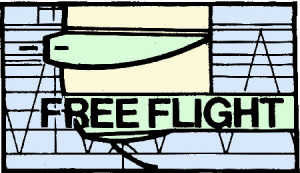 Bob Meuser on FF Sport Bob Meuser on FF Sport
Jetex Breakthrough: Far too often, I've seen an expert fail
three successive times to get his Jetex 150 engine to ignite. We have often pondered
the problem at club meetings. Larry Parsons suggested some sort of electric igniter.
But getting the lead wires through the case was a problem. Some sort of miniature
ceramic feed-through brazed into the sides of the case, a heating element connected
between them, could perhaps provide a solution. But nobody ever did it. Years passed.
Larry didn't give up; there had to be a simple solution.
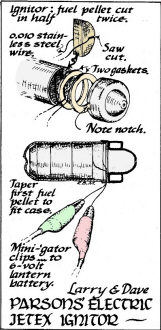 Whenever I see a beautifully elaborate solution
to a design problem, I know I'm looking at the signs of defeat. Great designs usually
look as though an idiot could have dreamed them up in two minutes. The solution
Larry finally came up with, and his son Dave put into practice, has the right look.
A stainless steel heater wire - nichrome might be better - loops around a notch
in a piece of fuel pellet. No feed-throughs are used; the heater wires are simply
brought out between two thin gaskets which are substituted for the standard gasket.
At a recent contest, Dave's engine ignited every time. He used the same piece of
heater wire all day. Whenever I see a beautifully elaborate solution
to a design problem, I know I'm looking at the signs of defeat. Great designs usually
look as though an idiot could have dreamed them up in two minutes. The solution
Larry finally came up with, and his son Dave put into practice, has the right look.
A stainless steel heater wire - nichrome might be better - loops around a notch
in a piece of fuel pellet. No feed-throughs are used; the heater wires are simply
brought out between two thin gaskets which are substituted for the standard gasket.
At a recent contest, Dave's engine ignited every time. He used the same piece of
heater wire all day.
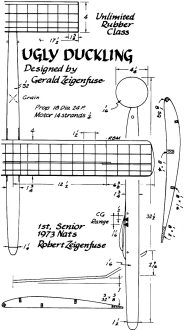 NATS Winning Mini-Unlimited: The
Unlimited Rubber-Powered Model rules permit 300 sq. inches of wing area, and such
models frequently carry nearly half a pound of precious Pirelli rubber. However,
much smaller models often perform disgustingly well. The Ugly Duckling (shown in
the three-view) is one such model, having won the Senior Unlimited Rubber event
at the 1973 NATS for Robert Zeigenfuse, with a score that would have taken second
place in the Open Age Group event. NATS Winning Mini-Unlimited: The
Unlimited Rubber-Powered Model rules permit 300 sq. inches of wing area, and such
models frequently carry nearly half a pound of precious Pirelli rubber. However,
much smaller models often perform disgustingly well. The Ugly Duckling (shown in
the three-view) is one such model, having won the Senior Unlimited Rubber event
at the 1973 NATS for Robert Zeigenfuse, with a score that would have taken second
place in the Open Age Group event.
Designed by Robert's father, Gerald Zeigenfuse, the Ugly Duckling was originally
designed to be flown with old 80-gm. Wakefield motors. The rules were changed. With
twice the rubber of a present-day Wakefield, and less gross weight, the performance
potential of such a plane is obvious; no small-field model is this! The greatest
problem with small unlimiteds is keeping them in sight for the period of a max.
The original model, built by Gerald in 1964, placed first in every contest in which
it was entered.
When Robert got to the age for serious competition and wanted to build an Unlimited,
the Ugly Duckling was the obvious choice. Robert made his NATS-winning flights,
incidentally, using a 1973-vintage Filatti rubber, the kind that barely turned the
prop and was scarcely of sufficient quality for strapping on wings. (The Fillatti
rubber currently sold is as good as good old Pirelli, according to some tests.)
However, it takes more than a well-built model of good designs to win; proper adjustment
is an essential ingredient. Robert spent most of the afternoon preceding the Unlimited
event at the NATS test-flying his model. That took lots of leg-work because of the
fierce wind, but the effort paid off.
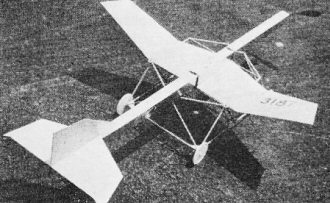 Rubber-Powered Speed Contest: Charlie
Sotich, fastest gum-bander in the Midwest, won the IMAC-sponsored speed meet with
a speed of 50.5 mph. That's a hair short of Jim Charlie Sotich's rubber-powered
racer covered the 200 ft. course in 2.7 sec. (50.5 mph] to win the IMAC-sponsored
Speed contest. McCracken's speed made at the 1973 NATS, but Charlie hasn't finished
developing his model yet. Rubber-Powered Speed Contest: Charlie
Sotich, fastest gum-bander in the Midwest, won the IMAC-sponsored speed meet with
a speed of 50.5 mph. That's a hair short of Jim Charlie Sotich's rubber-powered
racer covered the 200 ft. course in 2.7 sec. (50.5 mph] to win the IMAC-sponsored
Speed contest. McCracken's speed made at the 1973 NATS, but Charlie hasn't finished
developing his model yet.
Here are the specs: 24" span, 34.5" fuselage length, 7" plastic prop, 2.78 oz.
gross weight, of which about half is rubber. The lightweight dolly, which uses the
bottoms from foam coffee cups for wheels, falls off after takeoff. CG must be well
forward - 6% of the chord back from the leading edge - to keep the model from zooming
up. Solid balsa wing and tail, and built-up fuselage are employed. The model has
been flown on eight strands of 1/4" Pirelli wound only to two-thirds capacity. Charlie
hasn't broken a prop yet.
"There is still much testing to do," he says. A rubber speed model must be light
- not more than about 4 oz. per 100 sq. inches of wing area - and should have a
prop diameter no larger than one-third of the wingspan. It should be driven by plenty
of rubber.
The Illinois Model Airplane Club meet was held according to the NFFS rules: 200-ft.
course, 100 ft. wide; model must take off from a table; model may not rotate more
than one turn in flight; no dimension may exceed 36".
Charlie has been experimenting with a variety of plastic props, some of uncertain
heritage: one from England, another from France, a 7" Testers prop from an ROG kit,
among others. He suggests that the 9" Peck Polymers prop might be good if cut down
to about 7". He felt that the original solid 3/32" sheet balsa wing was a little
too flexible, and has constructed a light stick-and-tissue wing only 3% thick. We
hope he completes his experiments before the NATS, and shows up with a real sizzler
for the NFFS-sponsored unofficial Rubber-Power Speed event.
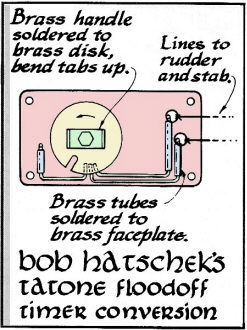 Tatone Timer Modification: From
the prolific pen of the old gadgetmaster himself, Bob Hatschek, comes America's
answer to the high price of European multi-function timers. It won't pop up the
tail for dethermalizing (a fuse DT can be used for that) but it will give time-sequenced
actuation of autorudder, autostab, and engine cut. If 1/32" wire is used for the
arms, and the bent ends of the arms are nearly touching, the time delay between
functions is about one-half second. For a longer delay, a knee can be bent into
one arm to better separate the ends. The rudder and stab lines can be hooked up
to the same arm for simultaneous actuation. Tatone Timer Modification: From
the prolific pen of the old gadgetmaster himself, Bob Hatschek, comes America's
answer to the high price of European multi-function timers. It won't pop up the
tail for dethermalizing (a fuse DT can be used for that) but it will give time-sequenced
actuation of autorudder, autostab, and engine cut. If 1/32" wire is used for the
arms, and the bent ends of the arms are nearly touching, the time delay between
functions is about one-half second. For a longer delay, a knee can be bent into
one arm to better separate the ends. The rudder and stab lines can be hooked up
to the same arm for simultaneous actuation.
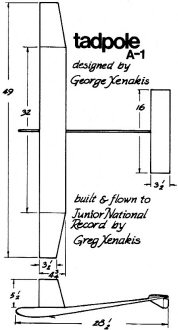 The lever on the left side goes to the flood-off
device. Those on the right may be connected in either order, depending on whether
the rudder or autostabilizer is to be actuated first. The disk position is shown
just before actuation of the flood-off device. The lever on the left side goes to the flood-off
device. Those on the right may be connected in either order, depending on whether
the rudder or autostabilizer is to be actuated first. The disk position is shown
just before actuation of the flood-off device.
The modification can be made to either a Tick-Off or Flood-Off timer, either
the new models or the old, as the stock faceplate is to be discarded anyway.
Tadpole: Designed by el maestro George Xenakis to A/1 Towline
Glider specifications, the Tadpole is one of those simple, ugly beasts that has
a special knack for finding thermals. One was flown to first place at the 1974 U.S.
Free Flight Championships by Greg Xenakis, and established a National Record as
well. The wings on the original series of models employed Jedelsky all-sheet construction.
These proved to be too weak, and had to be reinforced with spruce and plywood. The
newer series employs sheet balsa for the rear half of the wing, and built-up construction
for the front half. This promises to be both stronger and stiffer in torsion.
Posted February 11, 2023
|





